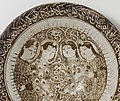Naschī

Naschī (Aussprache: Nas-chi mit ch=[χ]) oder die Naschi-Schrift (arabisch قلم النسخ, DMG qalam an-nasḫ, oder الخط النسخي, DMG al-ḫaṭṭ an-nasḫī, von نسخ, DMG nasaḫa ‚abschreiben, kopieren‘), ist eine kalligraphische Form der arabischen Schrift.
Die erste Kodifizierung der Schrift mit geometrischen Mitteln geht auf den Kalligrafen Ibn Muqla (885/6–20. Juli 940) zurück. Aufgrund ihrer Eleganz und ihrer besseren Lesbarkeit ersetzte sie ab dem 10. Jahrhundert allmählich die ältere, weniger gerundete Kufi als Hauptschrift für das Schreiben des Korans und entwickelte sich bald zur dominierenden arabischen Schriftart. Die Beschreibung der Eigenschaften des Propheten Mohammed in den Hilya wurden häufig im Naschī-Duktus ausgeführt.

Für Bücher und Zeitungen im Iran wird gewöhnlich der Schrifttyp des Nasch (نسخ) verwendet.[1]
Beispiele
Koran aus dem 14. oder 15. Jahrhundert mit Textkörper in Naschi
Steinputzschale aus dem 13. Jahrhundert, Iran, mit einem Gedicht in Naschi entlang des Rands
Siehe auch
Weblinks
- Nashi in: Das grosse Kunstlexikon von P.W. Hartmann
Einzelnachweise
- ↑ Bozorg Alavi und Manfred Lorenz: Lehrbuch der persischen Sprache. Langenscheidt, Leipzig usw. 1967, 7. Aufl. ebenda 1994, S. 273.
Auf dieser Seite verwendete Medien
(c) Khalili Collections / CC-BY-SA 3.0 IGO
Detail of Iranian stonepaste dish
Autor/Urheber: Der ursprünglich hochladende Benutzer war Dr. Andreas Birken in der Wikipedia auf Deutsch, Lizenz: CC BY-SA 3.0
Arabische Schrifttypen zusammengestellt von A. Birken
Dimensions of Written Surface: 15.4 (w) x 15.5 (h) cm
Script: naskh
This Qur'anic fragment contains the first chapter of the Qur'an entitled al-Fatihah (The Opening). Recited at the very beginning of the Qur'an, this surah proclaims God as Gracious and Merciful, the Master of the Day of Judgment, and the Leader of the straight path.
The illuminated upper and lower panels contain a text, outlined in gold ink to let the plain folio show through, stating that this surah is the opening of the Holy Book (Fatihat al-Kitab al-'Aziz) and contains seven ayahs revealed in Mecca. These illuminated cartouches contain gold vine and flower motifs interlacing on a blue background. In the right margin appear two gold and blue decorative roundels and one semi-roundel in the center.
The text itself is written in the cursive script called naskh, and each verse is separated by an ayah marker consisting of a gold six-petalled rosette with blue and red dots on its perimeter. Both the script and the illumination are typical of Qur'ans produced in Mamluk Egypt during the 14th and 15th centuries.
Above the first two ayah markers on the first line of text immediately after the initiatory bismillah appears the word la ("no") in red ink, indicating that the reciter must not stop at the places indicated. Finally, this fragment is particular in several ways: there are four extra verse markers at the very end of the surah, a mistake that has been rectified partially by the addition of the exclamatory, terminal praise amin ("Amen") between the last correct verse marker and the first additional marker. The spaces between the last three verse markers on the lowermost line remain empty.Die Fatiha aus einer Koranhandschrift von Hattat Aziz Efendi.





